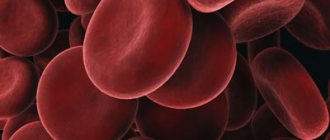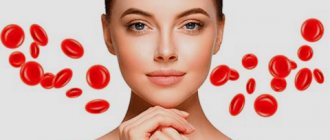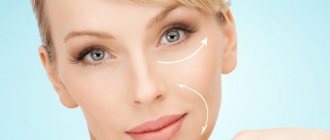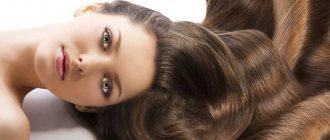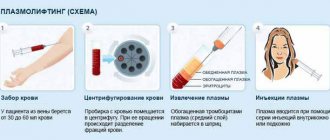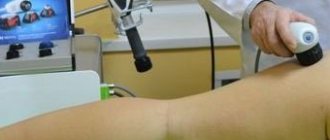Content:
Modern medical cosmetology offers patients various innovative and effective methods of skin rejuvenation and regeneration. One of these techniques is PRP therapy for the face and body. The procedure, based on the activation of natural recovery processes, has already proven itself on the positive side in a professional environment. Thanks to the PRP therapy procedure, you can make your skin more elastic and hydrated, significantly improve your complexion, and make wrinkles around the eyes and lips less noticeable.
The PRP therapy technique is used not only in cosmetology, but also in medicine. For example, in orthopedics, indications for prescribing the technique include diseases such as arthritis, arthrosis, and osteochondrosis.
What is PRP therapy?
PRP therapy is an invasive cosmetic procedure that involves the use of the patient’s own plasma to eliminate various external blemishes of the skin of the face and body.
Blood plasma contains a high concentration of platelets, which transport protein compounds into tissues, improves metabolism, activates the synthesis of its own collagen and elastin, promotes the activation of cellular metabolic processes and the production of natural hyaluronic acid.
Renewed cells stimulate the appearance of new cells, thereby improving skin tone, eliminating small and medium wrinkles, giving a lifting effect.
The main feature of the PRP therapy technique is to improve the condition of the skin by stimulating its own immune and regenerative functions, and not by introducing foreign substances under the skin. Due to this, the occurrence of allergic reactions or side effects is almost impossible. Using the patient's own blood eliminates the possibility of infection.
How PRP Therapy Works
Blood is a liquid tissue that consists of plasma with dissolved substances and cellular elements. The latter include red blood cells, white blood cells and platelets. The main component for PRP therapy is platelet-rich plasma. To obtain a therapeutic effect, their concentration must be 4-6 times higher than in normal blood.
The main function of platelets is hemostasis, but due to the structure and high activity of enzymatic processes, they are able to influence tissue regeneration. The internal structure of platelets does not have a nucleus, but there are mitochondria, which are energy centers, and three types of granules:
- a-granules – they contain growth factors, proteins that cause blood clots;
- d-granules - include components that are needed for reliable hemostasis: ADP, calcium ions, serotonin;
- g-granules – contain hydrolytic enzymes.
A-granules are of greatest importance for PRP therapy. They stimulate tissue regeneration, cell growth and division. The granules contain the following proteins that stimulate cellular processes. They are called growth factors. Platelets have the following types:
- platelet – stimulates cell division and ensures their survival;
- transformative – reduces signs of inflammation, suppresses apoptosis, accelerates collagen synthesis and wound healing;
- vascular endothelium – stimulates blood supply to tissues due to the permeability of the vascular wall;
- epidermal - starts the process of cell division;
- fibroblast growth factor – accelerates the growth of capillaries, increases the number of fibroblast cells, the synthesis of hyaluronic acid and collagen;
- insulin-like – enhances collagen synthesis, ensures cell differentiation and migration.
But to obtain highly active platelet-rich plasma, mitochondrial activity is also important. According to statistics, in 80% of the urban population it is reduced due to the influence of negative external and internal factors.
The biological effect of platelets is associated with an analgesic and antibacterial effect, and an anti-inflammatory effect. They increase the migration of stem cells to the area of damage and accelerate the reproduction of new ones.
The main effect of PRP therapy occurs locally in the area where the plasma is administered. But presumably it is possible to obtain a systemic effect, improving reparative processes and immune reactions throughout the body. But this aspect is still being studied.
Benefits of PRP Therapy
Plasma injection is especially effective in combating the first signs of facial skin aging. The technique reduces wrinkles, bags and bruises under the eyes, makes expression wrinkles on the forehead and around the lips less noticeable, improves complexion, relieves dry skin, increases its elasticity and tone. The procedure is effective for eliminating scars and acne scars, making them less noticeable. Due to the fact that PRP therapy increases the skin's own immunity, new rashes will not appear.
Having the widest possible capabilities, PRP therapy can not only rejuvenate the skin, but also helps restore the skin and enhance the effect after other cosmetic procedures.
PRP therapy is effective not only for improving the condition of facial skin and its rejuvenation, the technique can improve the condition of the skin in various parts of the body, as well as stop the process of hair loss, making it thicker and more beautiful. The technique effectively rejuvenates the skin of the hands, neck and décolleté, moisturizes and makes it more elastic, and eliminates stretch marks that appeared after lactation. PRP therapy will also help restore elasticity and improve the condition of the skin on the abdomen and thighs if there are stretch marks.
Indications
- premature skin aging;
- acne;
- hair loss;
- decreased turgor, appearance of flabbiness;
- fine wrinkles;
- dull complexion;
- bruises under the eyes, “tired” appearance;
- scars and other structural defects;
- atopic dermatitis, eczema, psoriasis;
- cellulite.
PRP therapy is also used to enhance the effect of other procedures, promotes rapid rehabilitation of the skin after aggressive hardware or chemical exposure, accelerating cellular restoration processes. The procedure can have a regenerative effect on any cells in our body. PRP plasma therapy can be performed as a stand-alone procedure or in combination with the following techniques:
Cosmetology
- PRP therapy (performed as an independent procedure and is an alternative to surgical techniques)
- PRP + laser therapy
- PRP + hyaluronic acid injections
- PRP + botulinum therapy
- PRP + thread lifting
- PRP + RF lifting
- PRP + peelings
Traumatology and orthopedics
- PRP + injury treatment
- PRP + joint treatment
Trichology
- PRP + scalp mesotherapy
Plastic surgery
- PRP + surgical facelift
Description of the procedure
The material for obtaining platelet-rich plasma is the patient’s own blood. It is taken from a vein, after which it is distributed into special vacuum tubes, connecting with a coagulant. The tube with the biomaterial is placed in an electronically controlled centrifuge, in which the blood is separated into platelet-rich plasma and formed elements (erythrocytes and leukocytes). From 8 ml of blood, 5 ml of PRP can be isolated into each tube.
For injections, disposable syringes are used. The area of administration is discussed with the patient in advance and depends on the indications. The duration of the manipulations is determined by the treatment area. A course is recommended consisting of 3-4 procedures, carried out at intervals of several weeks.
results
After plasma therapy, cellular balance is restored, collagenogenesis is stimulated, and the synthesis of elastin and intercellular substance is accelerated. Such changes become noticeable externally:
- the severity of wrinkles decreases;
- skin aging processes slow down;
- post-acne and other scars are smoothed out;
- bags and dark circles under the eyes disappear;
- the skin is filled with moisture, peeling is eliminated;
- When treating cellulite, the “orange peel” becomes less noticeable.
Indications and contraindications for PRP therapy
PRP therapy is indicated in the following cases: - Fading, sagging skin that has lost its firmness and elasticity; — Wrinkles, small scars; — Dry skin, peeling; — Acne, acne and post-acne; - Hyperpigmentation; — Consequences of excessive tanning; — Cellulite, stretch marks; — Skin restoration after laser or chemical peeling; - Hair loss.
Contraindications to the procedure: - Blood diseases; — Chronic diseases of the heart, liver and kidneys; - Oncological diseases; - Allergic reaction; — Pregnancy and lactation period.
PRP joint therapy
The greatest effect of PRP therapy is observed in the treatment of pathologies of the musculoskeletal system. Joints are difficult to regenerate, but using platelet-rich plasma can improve their condition. PRP joint therapy is performed for the following diseases:
- osteoarthritis of large and small joints;
- patellar tendinopathy;
- inflammation of the tendons of the muscles of the limbs;
- tendon injuries of various locations;
- osteochondropathy;
- pain in donor areas after taking autografts;
- tunnel neuropathies;
- slowly healing fractures.
When treating joints, PRP therapy allows you to achieve a pronounced analgesic effect and reduce signs of inflammation. With the intra-articular injection of enriched plasma, platelets reduce the level of pro-inflammatory cytokines and block chemical mediators that cause pain.
PRP therapy for joints has a chondroprotective effect. Platelet components retain the properties of the cartilage matrix under conditions of inflammation and enhance the division of chondrocyte cells. Healing of sites of cartilage damage occurs due to the migration of stem cells under the influence of components of platelet a-granules. They also enhance adhesion, aggregation and proliferation of cellular components. Therefore, cartilage is restored faster, and the content of extracellular matrix in it is greater.
Recovery is observed not only in hyaline cartilage, PRP therapy stimulates the regeneration of the synovial membrane, the fibrous structures of the meniscus in the treatment of knee joints.
Joint mobility also depends on the content of joint fluid. PRP therapy has a lubricating effect; it enhances the secretion of lubricin, which wets the surfaces of the joints and provides better gliding.
How is the procedure done?
2-3 days before the procedure, you must stop taking medications that affect blood clotting. The day before the procedure, it is recommended to refrain from drinking alcoholic beverages and fatty foods. There is also no need to use decorative cosmetics.
During preparation for the procedure, the cosmetologist may prescribe additional diagnostics to identify possible contraindications. If no contraindications for PRP therapy are identified, the doctor proceeds directly to the procedure itself.
Blood is drawn from the patient's vein (the volume depends on the size of the treated area). The skin is treated with an antiseptic solution and, at the client’s request, with an anesthetic cream. The blood is placed in a special centrifuge apparatus that separates the plasma, which is then injected into the subcutaneous layers to a depth of 3 mm.
PRP therapy promotes the activation of stem cells, and as a result, overall rejuvenation of the skin of the face and body. The technique is absolutely safe and very effective. To achieve the maximum positive effect, 4-5 procedures are usually necessary with a break between each of about 2 weeks. The exact number of procedures can only be determined by a cosmetologist, depending on the indications and individual characteristics of the patient. Plasma storage is excluded; a new blood draw is required at the next procedure.
The technique involves a certain pain, but there is no need to be afraid, the sensations are quite tolerable. Plasma injections are carried out using thin needles, and the puncture depth is only a few millimeters. This allows the pain of the procedure to be kept to a minimum.
How is the procedure performed at the Helen Baden clinic?
- You discuss with your doctor the necessary course of PRP therapy to achieve the best results.
- The nurse draws blood from a vein into selected tubes and performs centrifugation (separating blood cells in a centrifuge). The process takes approximately 5 minutes.
- The doctor injects the resulting drug. The procedure takes from 30 minutes to 1 hour, depending on the number of tubes used and injection technique.
The procedure is usually well tolerated. Anesthetic cream may be used if necessary.
Important! It is not recommended to carry out PRP therapy immediately before important events (possible formation of hematomas), during the acute period of inflammatory diseases and in general poor health. Be sure to tell your doctor about the medications you are taking.
Recommendations after the procedure
Plasma administration does not require a long recovery period. Complete healing of the injection sites occurs within the first 24 hours. To achieve the best effect after the procedure, you must follow a number of recommendations:
1. Do not use cosmetics for 12 hours after the procedure. 2. For 1 week, avoid visiting the solarium and staying in the open sun. To avoid hyperpigmentation at injection sites, use sunscreen. 3. Within 2-3 days after the procedure, refuse to visit the pool, sauna and bathhouse
After a course of procedures, many expect instant results and are disappointed when they do not find them right away. It is important to know that the result after the procedure will be noticeable no earlier than a week later. The effect of the PRP therapy procedure is increasing and long-lasting, and can last for several years.
PRP therapy in Krasnodar
An effective PRP therapy technique is presented at the Symmetry cosmetology clinic. Innovative equipment, high-quality certified materials, experienced specialists - all this is a guarantee of high-quality results. In addition, in our clinic the procedure is carried out exclusively under sterile conditions.
At the Symmetry clinic, the cost of PRP therapy procedures is one of the most affordable in Krasnodar. You can learn more about the method of conducting PRP therapy by scheduling a consultation with our specialists in any way convenient for you: by phone or using the feedback form. More information about the cost of PRP therapy in our clinic can be found in the Cost of Services section.
